Introduction
A times table is a list of multiples of a number. One can get the times table of any number by adding the same number in every next step.For instance, if we want to work out the time table for 2, we start with 2 and then add 2 in each step. The answer obtained in every step is a multiple of 2 and is known as multiplication fact.
Here’s how the times table of 2 will look.
Times Table of 2:
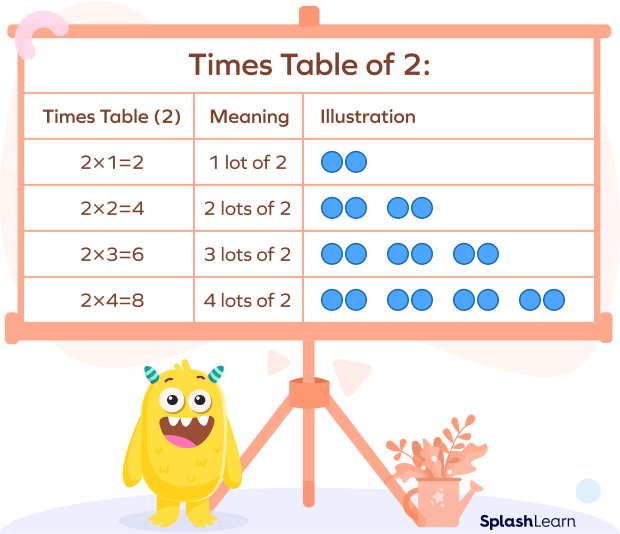
Another way to get the times table of any number is by simply multiplying the number. For instance, 2 x 1 = 2, 2 x 2 = 4, 2 x 3 = 6 and so on.
Recommended Games
Examples of Times Tables
Apart from 2, times tables of 5s, and 10s are useful for children. These numbers can help kids remember the other times tables as well.
Times Table of 5
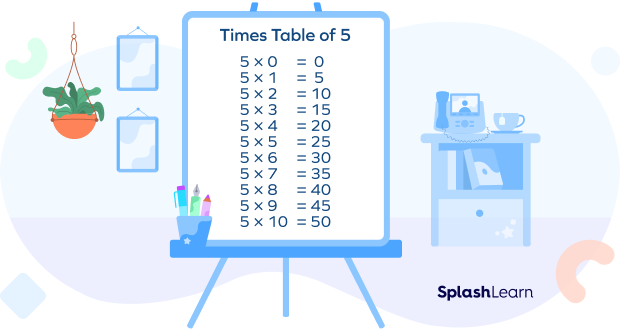
In the image above, we calculate as follows:
1 lot of 5 = 5
2 lots of 5 = 5 + 5 = 10
3 lots of 5 = 5 + 5 + 5 = 15
4 lots of 5 = 5 + 5 + 5 + 5 = 20, and so on…
Times Table of 10
In the same way, the multiplication table of 10 requires adding 10 to every lot.
1 lot of 10 = 10
2 lots of 10 = 10 + 10 = 20
3 lots of 10 = 20 + 10 = 30
4 lots of 10 = 30 + 10 = 40, and so on…
Take a look at the chart.

Recommended Worksheets
Why are Times Tables useful?
Remembering multiplication tables has numerous benefits. Some of them are discussed below:
- A student who is thorough with times tables can solve mathematical problems involving multiplication faster than those who do not know them.
- Understanding math concepts becomes more straightforward for students when they have a good grasp of times tables.
- Learning times tables not only helps students with multiplication but also with addition.
- Furthermore, it increases the confidence of the students.
- Memorizing times tables also improves the memory of the children.
- Multiplication tables are also essential for doing quick everyday calculations in classroom math problems.
Fun Facts
- The first times tables were used 4000 years back by Babylonians.
- Earlier, they used clay tablets to solve their mathematical problems.
- With the advancements in civilization, they needed a simpler and easier way of calculating their day-to-day mathematics problems, such as the times tables.
Tips to Learn Times Tables Easily
Children often feel that memorizing the tables is not easy for them. However, learning multiplication tables can be fun and simple using appropriate techniques. Here’s how:
- Start learning simple times tables first and leave the harder ones for later. For example, some easy multiplication tables are 2, 5, 9, and 10. Once they get the hang of the technique, that’s when they can go for the difficult tables, like 3, 4, 7, and 8.
- Memorizing becomes simple with pictures. A times table chart can help children learn better and faster.
- A quick table test every day can also help remember them.
- There are tricks for a few tables to learn. Using such tricks can alleviate the process.
For example:
Times Table of 1:
Accepting who you are is just what this times table is all about. Whatever number you multiply with 1, the result is the number itself.

Times Table of 2
The number 2 is what we call “Double or Nothing”. Any number you multiply with 2, will get doubled or will simply get added to itself.
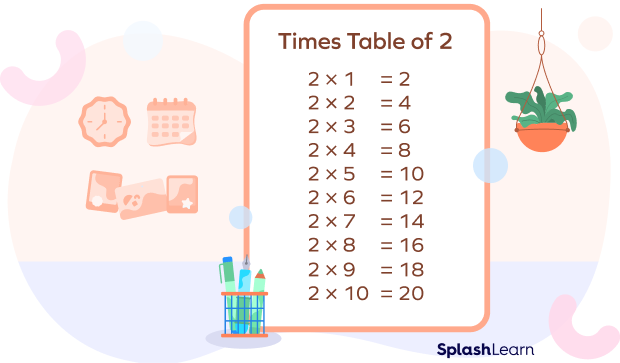
Times Table of 3
Here is the easiest trick to practice the times tables of 3. If you want to multiply a number by 3, multiply it by 2 first and then add the same number to it.

Times Table of 4
Time for doubling the doubles. There is no easy way out of this one. If you want to multiply a number by 4, double it once, and then double what you get!

Times Table of 5
Any number that you want to multiply 5 with, attach 0 at its end and then half it.

Times Table of 6
This one works like just the table of 3. If you want to find the product of a number with 6, go back to your 5s, multiply that number with 5 and then add the same number.
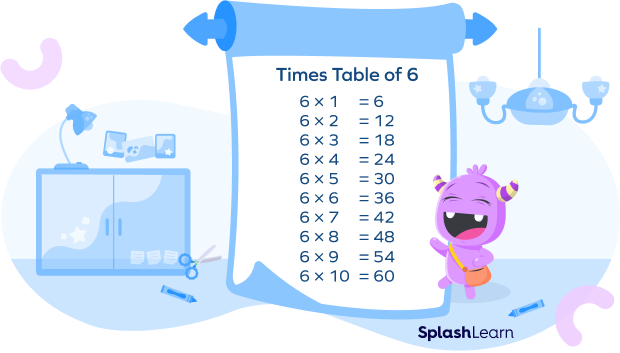
Times Table of 7
The easiest trick is to remember to keep adding a group of 7 as many times as the number we are multiplying 7 with.
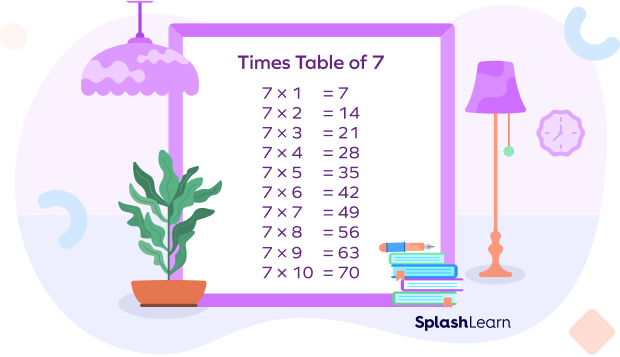
Times Table of 8
The easiest way to learn the times table of 8 is to add groups of “8” for all the multiples, just like in your times table of 7.

Times Table of 9
An easy way to remember this times table is to use the facts of 10.
To multiply a number with 9, attach a zero at the end of the number and then subtract the same number.
Another trick is that all the products can be considered to be made up of two columns. The first column has numbers from 0 to 9 in ascending order whereas the second column has numbers from 9 to 0 in descending order.

Times Table of 10
This is the easiest one. Just attach a zero at the end of whatever number you are multiplying with 10 and you have your answer.
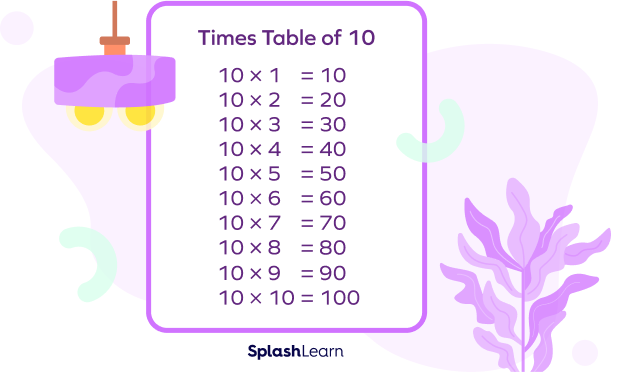
Solved Examples
Consciously or unconsciously, times tables have numerous everyday uses. Consider the examples given below:
Example 1:
Find out what can we write in place of question mark?
7×3=?
7 times 3 mean 3 lots of 7 or 7 lots of 3.

Or we can work out in another way,

Example 2:
Sam buys 2 liters of milk in one day. How many liters of milk does he buy in 5 days?
In our routine life, we come across questions as mentioned above. To answer them in a jiffy, it is crucial to know the concept of the times table.
Hence, if Sam buys 2 liters of milk in one day, his 1-day consumption is 2 x 1 = 2 liters.
Calculating his 5 days consumption will be 2 x 5 = 10 liters.
Therefore, the answer is 10 liters.
Example 03:
Parul studies for 4 hours daily. How many hours does she study in a week?
There are 7 days a week. So, one has to find Parul’s studying hours for 7 days.
Parul’s regular hours dedicated to her studies is 4 x 1 = 4 hours.
Parul’s dedicated hours to her studies in a week is 4 x 7 = 28 hours.
Therefore, Parul studies for 28 hours a week.
Practice Problems
Times Tables
8 times 7 = _____ ?
8 x 7 = 56
Suzan works 5 hours every day. How many hours does she work in 3 days?
Suzan’s work hours in one day = 5 x 1 = 5 hours
Suzan’s work hours in 3 days = 5 x 3 = 15 hours
What is 4 times 6?
4 x 6 = 24.
Sam eats 3 chocolates in one hour. How many chocolates does he eat in 7 hours?
3 x 7 = 21 chocolates
Learn more about times tables and other interesting topics in a more fun and easy way at SplashLearn with the best content for grades K-8. Start learning now!
Frequently Asked Questions
Are the times tables and multiplication tables the same?
Yes, times tables are also known as multiplication tables.
What is the best trick to learn 9’s times table?
Spread all 10 of your fingers before you. Put the left pinky finger down. You now have 9 fingers, which means 9 x 1 = 09. Now, to find 9 x 2 put the left ring finger down. You are left with 1 finger, a gap, and 8 fingers, which are 1 and 8. This is, 9 x 2 = 18. This trick works for the entire table.
What times tables are essential for children to know?
Children till 5th grade should know times tables till 12. Times tables of 2, 5 and 10 are the most basic times tables that are easy as well as essential in remembering the other times tables.
Which is the most difficult times table?
From times tables of 1 to 10 , The timetable of 7 is usually considered the most difficult for children to learn.




































